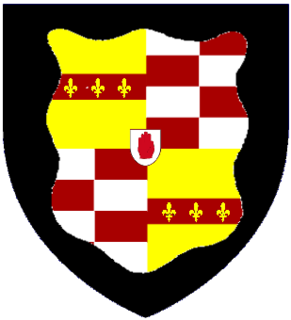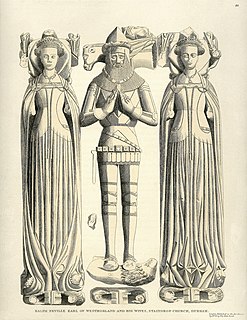
Earl of Carlisle is a title that has been created three times in the Peerage of England.

Baron Dacre is a title that has been created three times in the Peerage of England, every time by writ.

Baron Saye and Sele is a title in the Peerage of England held by the Twisleton-Wykeham-Fiennes family. The title dates to 1447 but it was recreated in 1603. Confusion over the details of the 15th-century title has led to conflicting order for titleholders; authorities such as Burke's Peerage and Debrett's Peerage do not agree on whether or not the 1447 creation is still extant.

Baron Stafford, referring to the town of Stafford, is a title that has been created several times in the Peerage of England. In the 14th century, the barons of the first creation were made earls. Those of the fifth creation, in the 17th century, became first viscounts and then earls. Since 1913, the title has been held by the Fitzherbert family.
Baron Multon of Gilsland was a title in the Peerage of England. It was created when on 26 August 1307 Thomas de Multon was summoned to parliament. At his death, his daughter Margaret inherited the title; she married Ralph Dacre, who was summoned to parliament as Baron Dacre and not as Baron Multon in 1321. If the Multon barony was extant thereafter, it can be supposed to have descended with the new Dacre one.

Thomas Dacre, 2nd Baron Dacre of Gilsland, KG was the son of Humphrey Dacre, 1st Baron Dacre of Gilsland and Mabel Parr, great-aunt of queen consort Catherine Parr, the sixth and final wife of King Henry VIII of England. His mother was the daughter of Sir Thomas Parr of Kendal by his wife, Alice Tunstall.

The Barrett-Lennard Baronetcy, of Belhus in the County of Essex, is a title in the Baronetage of the United Kingdom. It was created on 30 June 1801 for Thomas Barrett-Lennard, subsequently Member of Parliament for Essex South. He was the illegitimate son and testamentary heir of Thomas Barrett-Lennard, 17th Baron Dacre. He was succeeded by his grandson, the second Baronet, the son of Thomas Barrett-Lennard, Member of Parliament for Maldon. His son, the third Baronet, was childless and was succeeded by his younger brother, the fourth Baronet. This line of the family failed on the death in 1977 of his son, the fifth Baronet, who died without male issue. The late Baronet was succeeded by his third cousin once removed, the sixth Baronet. He was the son of Sir Fiennes Cecil Arthur Barrett-Lennard, Chief Justice of Jamaica, son of Captain Thomas George Barrett-Lennard, son of the first marriage of George Barrett-Lennard, son of John Barrett-Lennard, second son of the first Baronet. The sixth Baronet was a Catholic clergyman. As of 2014 the title is held by his second cousin, the seventh Baronet, who succeeded in 2007. He is the grandson of Trenchard Barrett-Lennard, son of the aforementioned George Lennard-Barrett by his second marriage. As of 31 December 2013 the present Baronet has not successfully proven his succession and is therefore not on the Official Roll of the Baronetage, with the baronetcy considered vacant since 2007.

Ralph Dacre, 1st Baron Dacre was an English peer.

Margaret Stafford was the daughter of Hugh de Stafford, 2nd Earl of Stafford, and Philippa de Beauchamp. She was the first wife of Ralph Neville, 1st Earl of Westmorland, and the grandmother of the 2nd Earl.

John Montagu, 3rd Earl of Salisbury and 5th and 2nd Baron Montagu, KG was an English nobleman, one of the few who remained loyal to Richard II after Henry IV became king.

Margaret Fiennes, 11th Baroness Dacre was a suo jure peeress having been created Baroness Dacre by King James I of England in 1604. She was the daughter of Thomas Fiennes, 9th Baron Dacre who was executed for murder in the year of her birth. His title and lands had been forfeited to the crown. Baroness Margaret's husband was Sampson Lennard MP.
Lady Margaret de Multon was the second to hold the title Baroness Multon of Gilsland. The title Baron Multon of Gilsland was created once in the Peerage of England. On 26 August 1307 Thomas de Multon was summoned to parliament as Baron Multon of Gilsland. As the only daughter and heiress, Margaret inherited the title and estates of her father. She married Ranulph (Ralph) de Dacre, who was summoned to parliament as Lord Dacre in 1321. The title and estates after Margaret inherited them were conveyed to the Dacre family jure uxoris.
Elizabeth FitzHugh was an English noblewoman. She is best known for being the grandmother of Katherine Parr, sixth queen consort to Henry VIII, and her siblings Anne Herbert, Countess of Pembroke, and William Parr, 1st Marquess of Northampton.
Thomas Dacre, 4th Baron Dacre of Gilsland, 8th Baron Greystoke was an English Member of Parliament and after his father's death a peer and major landowner in the counties of Cumberland, Yorkshire and Northumberland.
Humphrey Dacre, 1st Baron Dacre of Gilsland, was an English soldier, Cumberland landowner and peer.

William Dacre, 2nd Baron Dacre was an English peer. In the final months of his life, he was also 3rd Baron Multon of Gilsland. In some sources, he is called William de Dacre.

John Harington, 1st Baron Harington (1281–1347) of Aldingham in Furness, Lancashire, was an English peer, created Baron Harington by writ of summons to Parliament dated 1326.
Sir Nicholas Harrington of Hornby, Lancashire, was an English Member of Parliament. He was the third and youngest son of Sir John Harrington of Hornby and Katherine Banaster.

William Dacre, 5th Baron Dacre was an English nobleman and soldier. He was born in 1357, son of Hugh Dacre, 4th Baron Dacre and his wife Ela Maxwell, daughter of Alexander Maxwell of Caerlaverock. He succeeded his father as Baron Dacre upon the latter's death in 1383.

Hugh Dacre, 4th Baron Dacre (1335–1383) was an English nobleman. He was born in 1335, the youngest son of Ralph Dacre, 1st Baron Dacre and his wife Margaret de Multon, 2nd Baroness Multon of Gilsland. His two older brothers preceded him in the barony, but both died childless. His brother William, the second baron, married but died childless in 1361. His brother Ralph, the third baron, was a clergyman who died unmarried and without issue in 1375. Hugh may have been implicated in his predecessor's death; he and Nicholas Harrington were excommunicated by the Archbishop of York, likely in connection with the murder, and they were both presented for the murder at Preston, though they escaped long-term repercussions.











